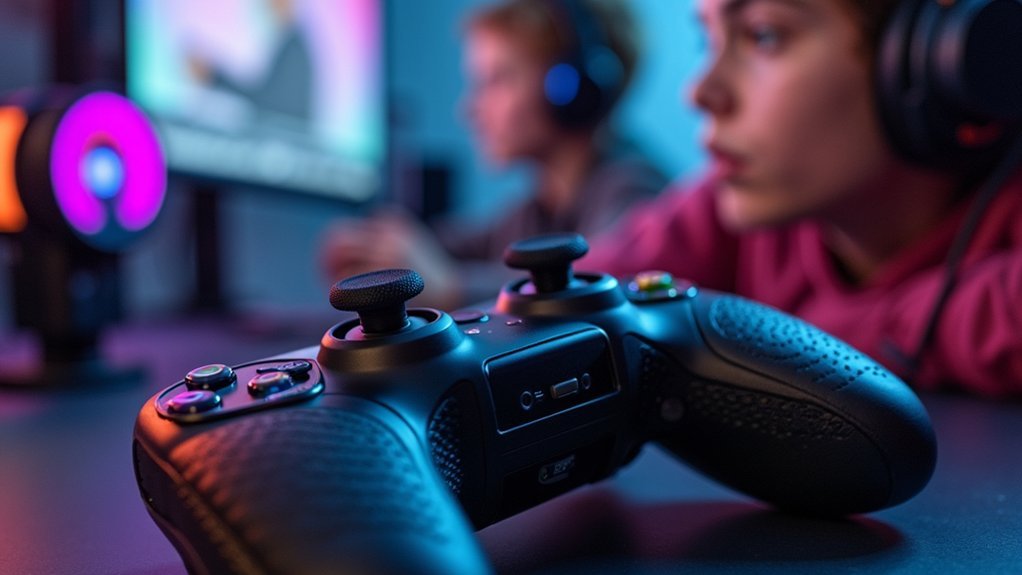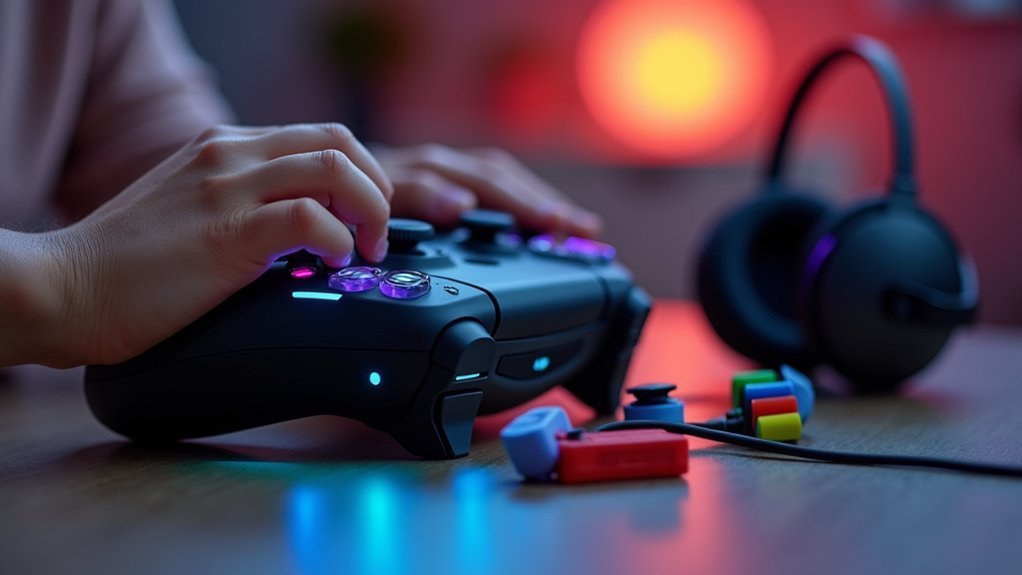Voice gaming controls like VoiceAttack, VoiceBot, and Talon Voice transform accessibility by converting spoken commands into game actions. These systems work well with PS5’s built-in voice commands and Xbox Adaptive Controller for various disabilities including limited mobility, cerebral palsy, and muscular dystrophy. You’ll need a quality microphone and compatible software to get started. Many gamers with disabilities have achieved competitive success using these technologies, proving their effectiveness in real-world gaming scenarios.
How Voice Control Technology Transforms Gaming for People With Disabilities

While traditional gaming has often presented significant barriers for people with disabilities, voice control technology is revolutionizing accessibility in this space. You can now play games using software that translates your spoken commands into keyboard inputs or mouse movements, eliminating the need for traditional controllers.
Programs like VoiceBot, VoiceAttack, and Talon Voice let you create customized voice commands tailored to your specific needs. Simple phrases like “jump,” “reload,” or “attack” replace complex button combinations, reducing frustration and increasing independence.
You’ll also find voice commands useful for maneuvering through menus, communicating in multiplayer games, and even launching titles hands-free. These systems provide therapeutic benefits while allowing users to enjoy entertainment and social interaction through gaming.
When combined with eye tracking technology, these voice control systems create all-encompassing accessibility solutions that open gaming to those with limited or no hand function.
Popular Voice Command Systems Compatible With Major Gaming Platforms
Several robust voice command systems now offer compatibility across major gaming platforms, making accessible gaming a reality for more players with disabilities.
VoiceAttack and VoiceBot stand out for PC gaming, with full VR integration for Oculus and HTC Vive devices. VoiceAttack provides powerful macro creation capabilities that allow players to control complex in-game actions with simple voice commands.
For console players, options include the PS5’s built-in voice commands (currently in preview in the US and UK) or Talon, which bridges consoles to voice control through a PC setup.
If you’re developing games, Talken – a Unity asset – provides cross-platform compatibility including mobile devices, with multilingual support and dynamic command management.
These systems can be enhanced with specialty hardware like the Xbox Adaptive Controller or Leap Motion, further expanding accessibility options for gamers with various mobility challenges.
Setting Up Voice Controls for Different Types of Games

How you configure voice commands varies considerably depending on the game genre and your specific accessibility needs.
Strategy games benefit from voice commands that enable quick unit selection and movement, while adventure games typically require navigation commands and interaction prompts.
For simulation games, you’ll want to set up voice controls for managing resources and directing activities. Text-based games work well with voice-to-text functionality to eliminate typing barriers.
Before starting, verify you have a quality microphone and compatible software for your PC or console.
Calibrate your microphone carefully and confirm game compatibility with your chosen voice control system. You might need specialized peripherals like voice-activated devices or adaptive controllers depending on your specific requirements.
Practice with basic commands before attempting complex gameplay to build confidence and accuracy. For 3D games requiring camera control, consider implementing continuous mouse movement techniques as covered in Episode 6.6 and 6.7 of the Voice Control Series.
Voice Command Customization Strategies for Specific Disabilities
When customizing voice commands for specific disabilities, you’ll benefit from gesture-free command design that eliminates the need for physical movements.
You can create simplified macro systems that bundle complex action sequences into single voice prompts, reducing cognitive load and physical strain.
These customizations work especially well when paired with other assistive technologies, allowing you to tailor the gaming experience to your unique abilities.
Services like VoiceAttack offer powerful tools for creating custom voice commands that can control virtually any PC game function without requiring manual input.
Gesture-Free Command Design
Voice command customization represents the cornerstone of accessible gaming for players with disabilities, offering flexibility beyond traditional control schemes. When designing gesture-free systems, you’ll benefit from natural speech patterns that create more intuitive interactions compared to complex manual inputs. Generative AI technology can now process and respond to various speech patterns, accommodating different accents and speech characteristics.
| Disability Type | Gesture-Free Command Benefit |
|---|---|
| Motor | Eliminates physical strain during gameplay |
| Cognitive | Simplifies interaction through natural speech |
| Visual | Reduces reliance on visual interface elements |
| Linguistic | Can be adapted for speech pattern variations |
| Sensory | Decreases overwhelming multi-sensory inputs |
For effective implementation, voice controls must adapt to different accents and speech limitations. Current AI technology still struggles with speech impairments, but customizable command systems allow you to reduce the number of required inputs, making games more accessible regardless of physical capabilities.
Simplified Macros System
Simplified macros transform complex gaming sequences into single voice commands, empowering players with various disabilities to control games through customized verbal cues.
You can create personalized voice shortcuts that execute multiple actions simultaneously, reducing the need for physical inputs.
With generative AI integration, you’ll be able to process simple phrases into complex in-game maneuvers. For example, saying “defend position” could trigger character movement, shield activation, and tactical positioning all at once.
These systems adapt to your unique speech patterns over time, accommodating variations in tone, volume, and pronunciation.
When designing your macro system, focus on incorporating feedback from your own gameplay experience.
The most effective voice control setups minimize barriers while maximizing functionality, allowing you to enjoy games that might otherwise be inaccessible due to mobility or cognitive challenges.
This technology is especially valuable for the 24% of gamers who report experiencing dexterity issues with conventional controllers.
Combining Voice Controls With Adaptive Controllers for Enhanced Accessibility

The integration of voice commands with adaptive hardware creates a powerful accessibility ecosystem for gamers with disabilities. By connecting voice control software like VoiceBot or VoiceAttack with the Xbox Adaptive Controller, you’ll create a customized setup that combines hands-free commands with physical inputs.
This multimodal approach lets you program complex macros that reduce the need for multiple physical actions. You can seamlessly switch between voice and adaptive switches based on your specific needs and comfort level.
The Xbox Accessories app enables you to create personalized profiles that integrate both control methods. These profiles can be quickly cycled through using the Profile button on the controller, eliminating additional setup time when switching between games.
These combined technologies support various disabilities including limited mobility, muscular dystrophy, and cerebral palsy. You’ll experience less fatigue during gameplay by alternating between input methods, maximizing your independence and enhancing your overall gaming experience.
Real-World Success Stories: Voice Gaming Control Applications
You’ll find impressive stories of disabled gamers achieving success through voice control technology across various gaming platforms.
Players with mobility impairments have reached competitive gaming ranks by mastering customized voice command systems that replace traditional controls.
Virtual reality has become accessible to many disabled gamers who can now navigate immersive worlds independently through voice-activated movement and interaction systems.
Gamers like Dan Bertholomey, who lost the use of his right arm in an accident, have found new opportunities to compete in eSports through adaptive technologies that combine voice commands with specialized hardware solutions.
Real-World Success Stories: Voice Gaming Control Applications
Across the gaming landscape, remarkable success stories highlight how voice control technology has transformed accessibility for players with disabilities.
You’ll find that voice commands have created genuinely inclusive gaming communities where players with limited mobility participate fully alongside others.
These technologies deliver therapeutic benefits beyond entertainment, offering stress relief and improved quality of life. Apple’s implementation of VoiceOver technology has inspired similar accessibility features in gaming platforms, enabling visually impaired users to navigate gaming interfaces effectively. The incorporation of voice controls reflects a growing commitment to accessible design principles throughout the industry.
What makes these success stories particularly valuable is how they’ve created feedback loops for improvement. When you share your experiences with developers, you’re helping refine these systems.
Voice-controlled gaming encourages participation from individuals who might otherwise be excluded, building a more diverse and representative gaming community that benefits everyone involved.
Competitive Gaming Achievement
Perhaps most inspiring among these success stories are the achievements in competitive gaming where voice controls have shattered perceived limitations.
You’ll find that voice commands are creating a more level playing field in esports, allowing players with disabilities to compete effectively against traditional control users.
Players with voice control systems have demonstrated remarkable success:
- DeadlyPG has achieved significant tournament victories using voice commands, proving competitive viability
- Voice control technologies have increased participation rates among gamers with mobility limitations
- Esports organizations are increasingly embracing accessibility features in response to these success stories
- Players report improved performance in MOBAs and strategy games where quick decision-making benefits from voice input
These achievements aren’t just personal victories—they’re driving industry-wide innovation in adaptive gaming technology. Organizations like AbleGamers continue to advocate for accessibility solutions that enable personalized voice commands to replace complex button combinations for players with limited mobility.
Virtual Reality Independence
While gaming applications dominate voice control technology discussions, virtual reality has emerged as a groundbreaking frontier for independence among users with disabilities. Voice commands now enable you to navigate virtual environments without physical controllers, offering unprecedented autonomy for those with mobility impairments.
You’ll find voice-controlled VR systems in diverse applications beyond gaming. Educational platforms provide interactive learning experiences where you can verbally interact with virtual scenarios. Virtual reality offers valuable training for users to practice accessible route planning and navigation skills in safe virtual environments before attempting real-world travel.
Therapeutic applications help you practice real-world skills in controlled environments. Even social VR platforms have become more accessible, allowing you to connect with others through voice commands rather than complex manual controls.
This integration of voice recognition into mainstream VR platforms—rather than specialized disability tools—reduces stigma while making immersive experiences more inclusive and affordable for everyone.
Overcoming Common Challenges With Voice-Activated Gaming
Despite the growing popularity of voice-activated gaming, players with disabilities continue to face significant challenges when using these systems. The inconsistent implementation across games and platforms creates frustration, while complicated voice commands can make gameplay difficult to navigate.
To overcome these barriers, you’ll need to:
- Look for games with standardized voice commands that follow intuitive patterns
- Seek titles offering robust audio cues and feedback for better orientation
- Choose platforms with accessibility settings that complement voice controls
- Join inclusive gaming communities that support and advocate for better voice integration
Voice-activated gaming has tremendous potential, but adoption remains limited. For many users, the high cost of specialized assistive technology presents a major obstacle, as identified by 30% of disabled gamers in recent research.
Future Innovations in Voice Recognition for Accessible Gaming
As AI technology continues to evolve, voice recognition for accessible gaming stands at the threshold of transformative change.
You’ll soon interact with NPCs that understand natural language, including slang and incomplete sentences, creating personalized gaming experiences based on your unique speech patterns.
By 2025, expect to see multimodal systems that seamlessly integrate voice commands with eye-tracking and haptic feedback, adapting to your specific needs.
These AI-driven voice agents will understand accents and speech impairments with unprecedented accuracy—up to 60% better than previous technology.
For competitive gamers, voice controls will enable faster command execution and reduce physical strain, allowing you to compete at higher levels regardless of mobility limitations.
Voice-driven companions will serve as virtual coaches, breaking down barriers through conversation rather than complex menus.
The new Xbox Adaptive Joystick available exclusively at the Microsoft Store complements these voice controls with adaptive hardware options for players needing customized physical interfaces.
Frequently Asked Questions
Are Voice Gaming Controls Affordable for Players on Limited Budgets?
Yes, you’ll find affordable voice gaming controls through free built-in options like Windows Speech Recognition, budget-friendly software ($10-50), and community-created solutions. High-end hardware isn’t necessary for basic voice command functionality.
Can Voice Controls Work Effectively in Noisy Environments?
Yes, you’ll find voice controls can work in noisy environments when using noise cancellation techniques. Modern systems employ adaptive algorithms like LMS and ICA to filter background noise, though performance may decrease in extremely loud settings.
Do Voice Commands Add Noticeable Input Lag During Competitive Gameplay?
Yes, you’ll notice voice commands add 100-500ms of lag during competitive gameplay. This delay is significant when competitive gamers can detect latencies as low as 48ms, potentially impacting your performance in fast-paced games.
How Steep Is the Learning Curve for Voice Control Software?
You’ll face a variable learning curve with voice control software. It’s steeper for some than others. Expect initial struggles but gradual improvement over time as you practice. Personalized features can help accelerate your mastery.
Are Voice Controls Compatible With All Languages and Accents?
No, voice controls aren’t yet compatible with all languages and accents. You’ll find better support for major languages, but AI advancements are improving recognition of diverse accents and expanding language options continuously.
In Summary
You’ve now got the tools to transform your gaming experience using voice controls. Whether you’re pairing commands with adaptive hardware or customizing setups for your specific needs, voice technology makes gaming more accessible than ever. As recognition software continues to improve, you’ll find even more natural and responsive ways to play. Don’t wait—start exploring these voice command options and join the inclusive gaming revolution today.





Leave a Reply